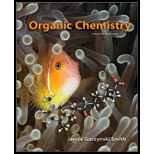
Concept explainers
Treatment of compound C (molecular formula
Compound C signals at
Compound D signals at
Want to see the full answer?
Check out a sample textbook solution
Chapter 20 Solutions
Organic Chemistry - With Access (Looseleaf) (Custom)
- Two compounds with the molecular formula C5H10O have the following 1H and 13C NMR data. Both compounds have a strong IR absorption band in the 1710–1740-cm_1 region. Elucidate the structure of these two compounds and interpret the spectra. (10) (a) 1H NMR: d 2.55 (septet, 1H), 2.10 (singlet, 3H), 1.05 (doublet, 6H); 13C NMR: d 212.6, 41.5, 27.2, 17.8 (b) 1H NMR: d 2.38 (triplet, 2H), 2.10 (singlet, 3H), 1.57 (sextet, 2H), 0.88 (triplet, 3H); 13C NMR: d 209.0, 45.5, 29.5, 17.0, 13.2arrow_forwardWhat is the structure of the compound with the formula C5H12O, if it has a strong broad IR signal centered near 3330 cm-2, and the 1H-NMR spectrum is: 0.91 ppm (3H triplet) 1.19 ppm (6H singlet) 1.50 ppm (2H quartet) 2.24 ppm (1H singlet)arrow_forwardTreatment of compound E (molecular formula C4H8O2) with excess CH3CH2MgBr yields compound F (molecular formula C6H14O) after protonation with H2O. E shows a strong absorption in its IR spectrum at 1743 cm-1. F shows a strong IR absorption at 3600–3200 cm-1. The 1H NMR spectral data of E and F are given. What are the structures of E and F?Compound E signals at 1.2 (triplet, 3 H), 2.0 (singlet, 3 H), and 4.1 (quartet, 2 H) ppmCompound F signals at 0.9 (triplet, 6 H), 1.1 (singlet, 3 H), 1.5 (quartet, 4 H), and 1.55 (singlet, 1 H) ppmarrow_forward
- There are several isomeric alcohols and ethers of molecular formula C5H12O. Two of these exhibit the following 1H-NMR spectra. Propose a structure for each of the isomers. Isomer A: δ = 0.92 (t, 7.8 Hz, 3 H), 1.20 (s, 6H), 1.49 (q, 7.8 Hz, 2H), 1.85 (s, 1H) ppm Isomer B: δ = 1.19 (s, 9 H), 3.21 (s, 3H) ppmarrow_forwardThe compound whose 1H NMR spectrum is shown has the molecular formula C7H7Br. Follow the following questions to predict the unknown structure. 2(a) Degree of the unsaturation of this compound is= , 2(b) The two distinct peaks in the aromatic region of the 1H NMR indicate that compound is .................-disubstituted = 2(c) The splitting pattern of the peak at 2.31 δ is = 2(d) The group that corresponds to the splitting pattern in 1(c) is = 2(e) This compound has the plane of symmetry Yes or No = 2(f) The name of the unknown compound =arrow_forwardTreatment of compound C (molecular formula C4H8O) with C6H5MgBr, followed by H2O, affords compound D (molecular formula C10H14O). Compound D has a strong peak in its IR spectrum at 3600–3200 cm−1. The 1H NMR spectral data of C and D are given. What are the structures of C and D? Compound C signals at 1.3 (singlet, 6 H) and 2.4 (singlet, 2 H) ppm Compound D signals at 1.2 (singlet, 6 H), 1.6 (singlet, 1 H), 2.7 (singlet, 2 H), and 7.2 (multiplet, 5 H) ppmarrow_forward
- Treatment of alcohol A (molecular formula C5H12O) with CrO3, H2SO4, and H2O affords B with molecular formula C5H10O, which gives an IR absorption at 1718 cm−1. The 1H NMR spectrum of B contains the following signals: 1.10 (doublet, 6 H), 2.14 (singlet, 3 H), and 2.58 (septet, 1 H) ppm. What are the structures of A and B?arrow_forwardTreatment of compound E (molecular formula C4H8O2) with excessCH3CH2MgBr yields compound F (molecular formula C6H14O) afterprotonation with H2O. E shows a strong absorption in its IR spectrum at1743 cm−1. F shows a strong IR absorption at 3600−3200 cm−1. The 1HNMR spectral data of E and F are given. What are the structures of E andF?Compound E signals at 1.2 (triplet, 3 H), 2.0 (singlet, 3 H), and 4.1 (quartet, 2 H) ppm Compound F signals at 0.9 (triplet, 6 H), 1.1 (singlet, 3 H), 1.5 (quartet, 4H), and 1.55 (singlet, 1 H) ppmarrow_forwardTreatment of 2-methylpropanenitrile [(CH3)2CHCN] with CH3CH2CH2MgBr, followed by aqueous acid, affords compound V, which has molecular formula C7H14O. V has a strong absorption in its IR spectrum at 1713 cm−1, and gives the following 1H NMR data: 0.91 (triplet, 3 H), 1.09 (doublet, 6 H), 1.6 (multiplet, 2 H), 2.43 (triplet, 2 H), and 2.60 (septet, 1 H) ppm. What is the structure of V? We will learn about this reaction in Chapter 20.arrow_forward
- Propose a structure for each of the following two isomers with formula C6H14 given their 1H-NMR spectra. Isomer A: δ = 0.84 (d, 12 H), 1.39 (septet, 2H) ppm Isomer B: δ = 0.84 (t, 3 H), 0.86 (t, 9H), 1.22 (q, 2H) ppmarrow_forwardThe 1H-NMR spectrum of compound R, C6H14O, consists of two signals: d 1.1 (doublet) and d 3.6 (septet) in the ratio 6:1. Propose a structural formula for compound R consistent with this informationarrow_forward
 Organic ChemistryChemistryISBN:9781305580350Author:William H. Brown, Brent L. Iverson, Eric Anslyn, Christopher S. FootePublisher:Cengage Learning
Organic ChemistryChemistryISBN:9781305580350Author:William H. Brown, Brent L. Iverson, Eric Anslyn, Christopher S. FootePublisher:Cengage Learning
